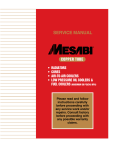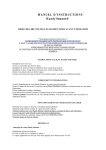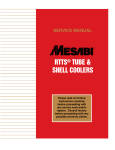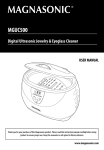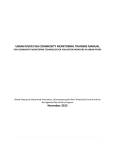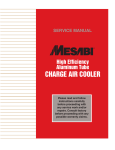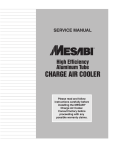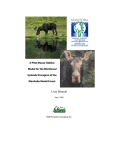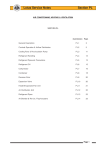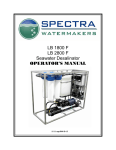Download 80-967 - Allied Systems Company
Transcript
Section 2-6 Quality People - Quality Products Service Instructions Mesabi Copper Tube Radiators and Air to Air Coolers (CAC) Allied Systems Co. reserves the right to make changes to new equipment without incurring the obligation to make such changes to equipment previously manufactured. 80-967, REV. 6/2014 1 Standard Parts of a Typical MESABI Radiator Core ® SINGLE UPSET TUBE Additional Tube Styles Exploded view of a typical MESABI® water jacket core (Sold As Assemblies Only) PART NO. DESCRIPTION TOP HEADER PLATE (bolted design) ............ ...... refer to parts page TOP RUBBER SEAL .............................................. refer to parts page TOP FELT AIR BAFFLE ......................................... refer to parts page BREAKER TOOL.................................................................... 226672 (for freeing tubes from rubber seal) RUBBER TUBE STAY.................................................... ‘F’ (for staggered MESABI Cores only) ........................ ‘H’ 227263 226668 RUBBER TUBE STAY END PIECE .............................. ‘F’ (for staggered cores only) ........................................ ‘H’ 252917 226669 BOTTOM FELT AIR BAFFLE ................................. refer to parts page ITS™ (Individual Tube Support) Used on H, L, and V style cores RUBBER SEAL – LOCKING GROOVE ................. refer to parts page BOTTOM HEADER PLATE (bolted design) ........... refer to parts page RUBBER PLUG ...................................................................... 226670 Note: Plugs are for temporary plugging of ferrule holes until replacement tubes can be installed. Plugs must be installed dry and are not recommended for systems operating over 15 P.S.I. INSTALLATION TOOL ........................................................... 226671 (for removing and installing tubes) STAY Used on “L” style cores ITS Tube Installation Tool P/N 252922 (See page 5, TM Figure 8) HEADER PLATE HOLE CLEANING BRUSH – P/N 259069 STAY Used on “M” style cores SEAL AND TUBE END LUBE BRUSH – P/N 252920 LOCKING GROOVE SEAL must be used at the bottom. The tube bead will seat in the seal inner groove. Tube Locking design 2 Bottom Plate STAY Used on “V” style cores Quality People - Quality Products Cleaning Tube Removal STANDARD EXTERNAL CLEANING HELPFUL HINTS: To maintain efficiency and assure maximum life of a MESABI ® Core, reasonable care must be taken when cleaning. Most radiator shops use a hot alkaline soap, caustic soda or chemical additives in their boil-out tanks, which attacks solders. If a MESABI ® tube is soaked in such a solution, the solder bond between the finning and tube will be adversely affected. If it is known that the particular solution used is not harmful to solder, then it will not hurt the solder used on the MESABI ® tube. Be sure to completely rinse the cleaned tube/core in clean water after removing from the boil-out tank. In most cases, it may be best to blow out any dry dirt with a high pressure air gun prior to washing the core with a high pressure hot water washer. For general external cleaning, a high pressure, hot water washer (with or without soap) can be used at pressures up to 1200 psi (8274 KPa). (CAUTION! To prevent fin deformation, you must stay a few inches away from the core and spray straight into the core not at an angle. If the cooler is still in the machine, you may have to use an offset angled nozzle so that you can spray straight into the core. If there is any doubt, try your cleaning method on a small portion of the core first.) It is important to start on the air exit side. Work from the top to the bottom. Concentrate on small areas and work slowly. Wash until the water exiting the opposite side is free from dirt and debris. Complete this side and then repeat the process from the other side. • Clean the core prior to removing tubes. • To avoid bending or kinking tube ends, reduce the angle of the tube as it’s being pulled from the top seal. • If the core has a center tank, remove the top core tubes and seals first. • If the core has an ITS™ (Individual Tube Support) or stay system with support bars, mark the bars front and back before removing, to ease reassembly. • To assist in the removal process, spray WD-40 on the top end of tubes. • If tubes are difficult to remove, try using the breaker tool and removal tool simultaneously. STEP 1. Loosen the tube by using Breaker Tool, Allied P/N 226672, as shown in Fig. 1. The Breaker Tool should be placed at top or bottom, not at middle when freeing tube from seal. Lightly twist the tube back and forth, to loosen tube from seals. Fig. 1 EPOXY-COATED CORES Epoxy-coated cores must be cleaned with care to assure the coating is not damaged. 1. A high pressure hot water washer can normally be used. Use a “fresh” water supply. Water temperature should not exceed 1800F. Do not steam clean. The nozzle should be kept approximately 12 inches away from the core. CAUTION! We do not recommend a pressure rating because as epoxy ages the coating does become brittle and might be damaged at higher pressures. We recommend that you try your cleaning method on a portion of a single tube first. 2. Wash the core thoroughly and methodically, starting at the top and working towards the bottom. Do not wash in one area for extended periods. The core will be clean when the water exiting the core is clean. 3. Blow off excess water with air. Epoxy coatings are not meant for submergent duty. L&M Radiator does not warrant against corrosion, but this coating, properly cared for, will help increase the service life and efficiency of your cooling system. STEP 2. After tube is free, place upper jaw of Installation Tool P/N 226671 around the round portion of tube, just below the flattened portion. Place lower jaw on top of bottom seal, see Fig. 2. Squeeze handles of tool together and raise tube only enough to clear bottom seal. Fig. 2 INTERNAL CLEANING In most cases just flushing the inside of the tubes with a high pressure hot water washer, with soap, will do the job. Rinse thoroughly with clean water. 3 Tube Removal (continued) STEP 3. Put down tool and swing tube out just far enough to allow it to be pulled down and out of its top seal, as shown in Fig. 3. Remove all tubes in the row, repeating the above procedure. Fig. 3 If you are working with any of L&M’s ITS™ or stay systems with interlocking tabs, the tube must be raised high enough so that the interlocking tab clears the adjacent groove, as shown in Fig. 4. Fig. 4 Seal Installation HELPFUL HINTS: • L&M recommends installing new MESABI ® seals when tubes are removed. • After removing the old seals, clean the plate holes of any foreign debris with Allied P/N 259069 header plate hole cleaning brush placed in an electric or air drill. • Clean out inside of tanks and blow out plate holes with air. • Install new seals in clean dry holes. Do not apply any lubricant to header plate holes. • If the core has a center tank, do not install seals at the bottom of the top core until all the tubes are installed in the bottom core. • For ease of seal installation, soak seals in hot water just prior to installing. • Make sure you use proper seal part number (see your parts manual). With your thumb, start the new MESABI ® seals into the holes and push them part way in. Care must be taken not to install seals too far into the header plate. A properly installed seal has a crowned or convex top surface, and the tube hole is slightly flared at the opening. A seal that is installed too far into the header has a concave top surface and the tube hole is noticeably smaller in diameter as shown in Fig. 5. Over-installed seals will make tube installation more difficult and are much more likely to be damaged during tube installation. The use of a hammer directly on the seal can easily cause seals to be installed too far into the header plate. L&M recommends the use of a flat plate 3/8” x 3”x 6” placed over the seals. Hitting with a rubber mallet will allow the seals to be properly installed. Fig. 5 ON THE LEFT: Properly installed seal. RIGHT: Cleaning Tube Ends Before the original tubes are reinstalled, the tube ends must be clean of foreign material. L&M recommends polishing the tube ends with a polishing wheel (Grainger #5A725 – use Qty. 5 together) and a copper polishing compound (Grainger #3W769). If the debris cannot be removed by polishing, L&M recommends using a piece of fine grit emery cloth or steel wool. If there is a lot of debris on the tube ends, use a 6” or 8” diameter wire wheel brush with a wire size of .006 or .008. Larger diameter wire sizes could damage the tube ends. Try installing a tube. If it does not slide easily into the top and bottom seals, try polishing the tube ends as per above. 4 Seal installed too far into header. CORRECT INCORRECT Lubricating Seals and Tube Ends For ease of tube installation and to minimize the chance of scuffing or tearing rubber seals during tube installation, both top and bottom seals and both tube ends must be thoroughly lubricated, (seals 226663 & 226664 use lube P/N 252933, seals 250669 & 250690 use lube P/N 259070). Using a 1/2” diameter brush (Allied P/N 252920) and a minimal amount of lubricant, apply a thin film into each seal hole and onto each tube end. Quality People - Quality Products Tube Installation CAUTION! If a tube seems difficult to install into a seal, STOP and figure out WHY! One of the following reasons could be the answer. 1. A tube or seal with inadequate lubrication. 2. Improperly installed seal that could be pushed too far into the header plate hole. 3. Damaged tube end. 4. Trying to insert the tube into the seal at too steep of an angle. 5. Tube is not centered in seal. NOTE: If, for any of the above reasons, a tube is difficult to install, the seal should be removed and inspected for any scuffing marks, tears, or cuts. If there is any doubt, replace the seal. HELPFUL HINTS: • If you are working with a center tank core, the bottom core must be assembled before the top core. • Minimize the angle of the tube as it’s being installed into the top seal. • Make sure the tube is centered in the bottom seal before any force is applied to pull or push into place. • For ease of tube installation, install the tubes behind the side member gussets in each row first. Install the tubes behind the left side gussets, working towards the core center. Then, going to the far right hole, in the same row, install the tubes working towards the core center. • Individual rubber tube stays and, in some cases, tube stay ends are necessary to interlock the tubes. For part numbers see your parts manual . If more detailed information is required for proper assembly of cores using tube stays and tube stay ends, contact Allied Systems Service Department at 503-625-2560. • If your core style includes plastic tube supports, see page 6 for ITS™ or stay orientation prior to starting. STEP 1. To minimize installation angle, tubes in any given row must be installed from the closest header plate edge. Use a minimum of angle and a slight twisting, pushing motion, to push the top end of the tube into the top seal. Push it far enough in so the bottom of the tube clears the top of the bottom seal. If you are working with any of L&M’s ITS™ or stay systems, you will need to insert the tube far enough into the top seal to allow clearance for the tabs to be aligned with the grooves when the tube is pulled down into the bottom seal (see Figs. 4. and 6.). Please note that when ITS™ or stays with interlocking tabs and grooves are present, the bottom end of the tube should be centered in the seal and then pulled down slightly into the seal so that the tabs engage the adjacent grooves. NOTE: See page 6 for ITS™ or stay orientation in the core. Fig. 6 STEP 2. Center bottom end of tube into respective seal in the bottom header plate. Then, push tube down and into seal until the formed bead is seated into the locking groove of the bottom seal. This may be done by grasping tubes by hand and pulling the tube downward until seated, or by using Installation Tool, Allied P/N 226671. Fig. 7 This tool has a semicircular form on the end of the handle. Place this end on the formed bead of the tube and push downward until seated, as shown in Fig. 7. Now, complete the row of tubes. Precaution should be taken to make sure formed bead is seated into bottom seal, and that the tubes are straight and aligned to assure maximum air flow. If you are working with an ITS™ system (refer to page 2 and page 6, Fig. 9, for identification), use Allied tube installation tool P/N 252922 to pull the tube into the bottom seal. (See Fig. 8.) Hook the slotted end of the tool behind the front tab on the ITS™ tube support. Using the tool and your free hand, center the bottom end of the tube into the bottom seal. At the same time guide the dovetail slots into the tabs on the ITS™ tube support. Once in place, and with the tool P/N 252922 still hooked onto the ITS™ tube support, pull the tube into the bottom seal until the formed bead is seated into the locking groove of the bottom seal. Fig. 8 Push the remaining tubes in this row. Use the same procedure on all remaining rows except the front side row. 5 Tube Installation (continued) STEP 2. (CONTINUED) Tube Support Orientation All illustrations front side as viewed from top. A. ITS™ (can be used on H, L, or V style cores) Make sure the tabs on the ITS tube supports are facing to the front and to the right. Caution! To prevent seal leaks, do not allow the felt baffles to be pushed (top) or pulled (bottom) into the seal hole when installing the front row of tubes. STEP 4. (If applicable) If you are working with the ITS™ or stay support system, install the appropriate support bar as shown in Fig.10. Fig. 8 Fig. 9 Fig. 10 FRONT B. “L” Stay Fig. 9 FRONT C. “M” Stay PRESSURE TESTING FRONT D. “V” Stay FRONT NOTE: If you are working with an older stay style that has rubber tube stays (see Exploded View page 3) and need assembly assistance, please contact Allied Systems Service Department at 503-625-2560. STEP 3. Before you install the front side row, install the felt air baffles. 6 The support bar part number has been stamped on the outside face. Check your parts page for proper installation. Using a rubber mallet, gently tap the bar into place and secure to the side member. Pressure testing procedure that follows recommends 10 test to pressure testing to 15 psi (103 kPa). YouFig. should rating specified on tag attached to your cooler. If there is no pressure rating specified, please contact Allied Systems customer service with the part number of your cooler. (Caution: Always bring air pressure up slowly and always wear protective gear) 1. Pressurize with compressed air to 15 psi (103 kPa) and submerge in water. Fig. and/or 11 2. Seal any leaks at the test fittings cover plates. 3. Repair any other leaks as needed. 4. Cycle test after successful initial test. Hold pressure at 15 psi (103 kPa) for 15 minutes. Note that the time starts after all leaks are fixed and air bubbles have subsided. Cycle to zero psi and pressure back up to 15 psi (103 kPa). Hold at 15 psi (103 kPa) for one minute. Repeat three more times and then hold the last cycle pressure at 15 psi (103 kPa) for five minutes. Should any leaks appear, fix them, and start the cycle test over. If you have any questions regarding the procedures described in this Service Manual, please contact Allied Systems Company at 503-625-2560 and ask for Customer Service.






